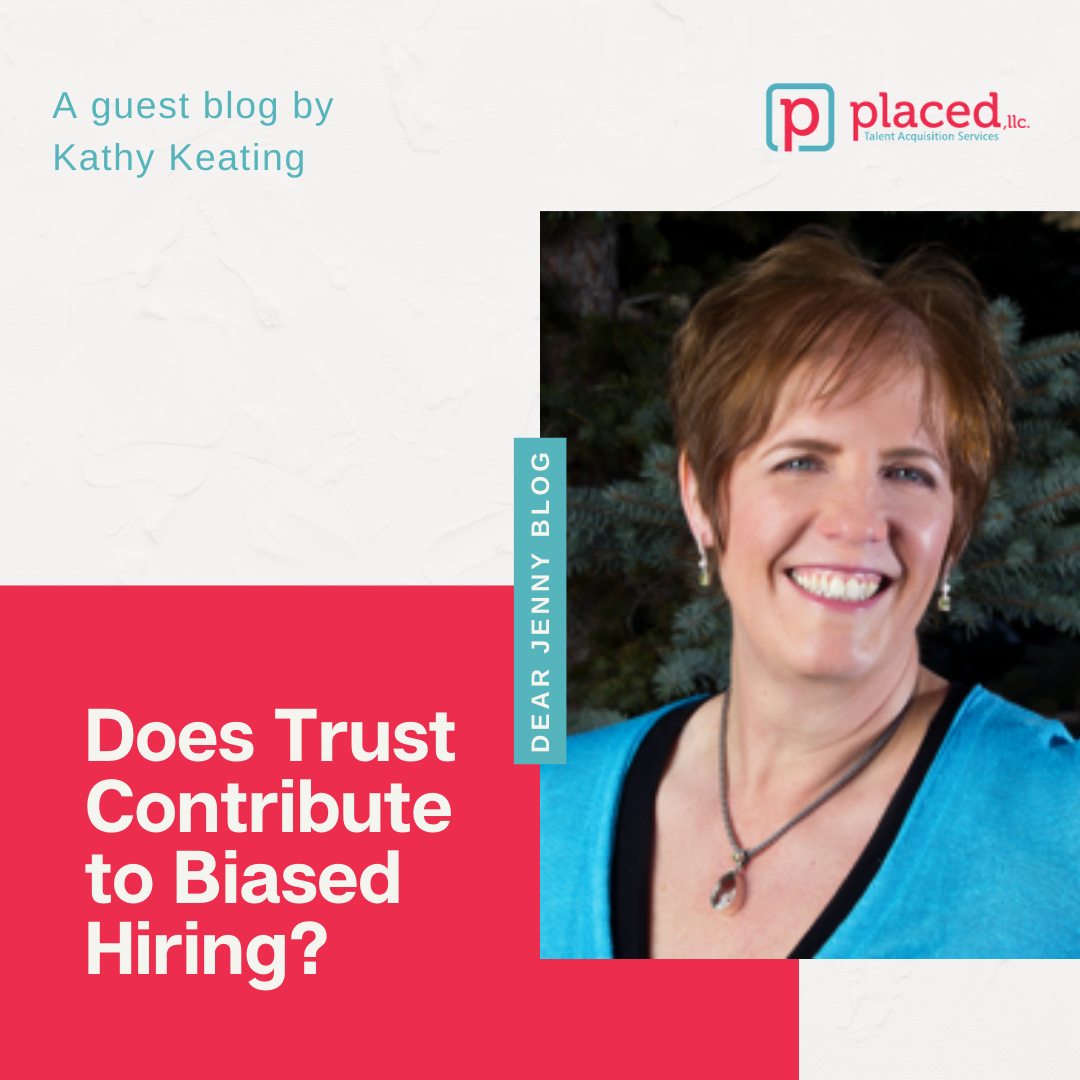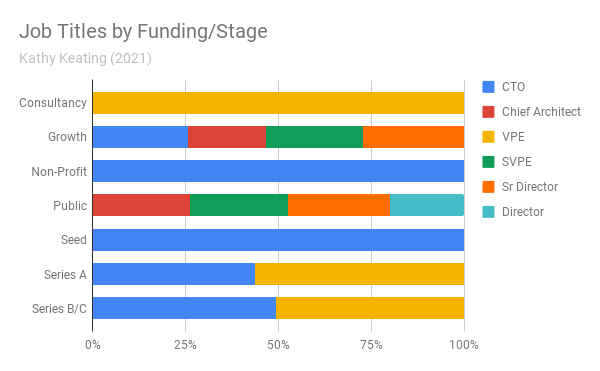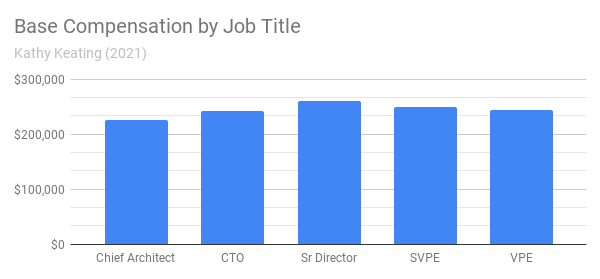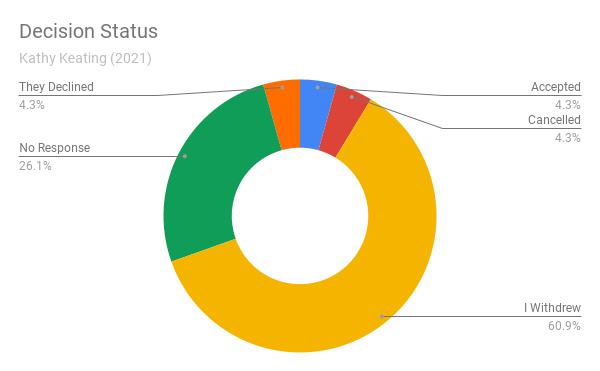
Does Trust Contribute to Biased Hiring? By Kathy Keating
This week, I’m sharing an article from a brilliant friend of mine – Kathy Keating. In this article, she’s talking about biased hiring. This is a must-read for anyone who hires (or plans on interviewing) soon. You can learn more about Kathy and read more of her work here: https://kathkeating-cto.medium.com/
Enjoy!
Jenny
A couple of weeks ago I made the following bold statement on LinkedIn that seems to have resonated with many:
…the tech hiring process is so broken. Talent says they can’t get hired. Employers say they can’t find qualified people. Trust is nowhere is the process. Companies are simply shifting every developer “one company left” (not increasing the talent pool) and very few are focused on retention. It does not need to be this way…
Mere days later we are now faced with angst from several employers regarding Colorado’s Equal Pay for Equal Work law to display salary bands on job ads. Do they think their salary bands are proprietary?
I recently completed a job search myself. I thought I would unpack the data from my own search to see if my hypothesis plays out. This article also goes out to those of you who have asked me to share my process.
Power Up My Search
To start my recent search, I actively notified two of my networks (Techstars Mentors, and 7CTOs). I turned on LinkedIn Availability so that recruiters could see I was looking. I sent a request out to a few close allies, and I tweaked my resume to add recent experience.
I’m highly data-driven, so I created an Airtable grid to track my opportunities. This included a full weighted-matrix on which I could evaluate every company across multiple vectors that were important to me. (We’ll talk about how that works a bit later.)

Getting Seen
My data clearly shows that having strong and proactive peer networks already in place was key for me to be seen by potential employers. Almost half of my opportunities came through referrals. Most of the rest came inbound through LinkedIn.
I did cold-apply to a small number of opportunities. For 100% of my cold applies, I received no acknowledgment that my application as received. 100% of these cold applies were to Colorado-based employers.

Referrals were plentiful and they came from a wide variety of sources. My tightest, and most proactive, relationships clearly paid off — 64% of my referrals came from people I know personally and interact with often.

LEARNING: These results are an amazing example of trust in action. Referrals have high trust. Cold applies have low trust. Build and activate networks of peers now, so that you can activate that network when you need it.
Targeting a Growth Stage Company
I’ve always been a believer in seeking roles, companies, and missions that interest me. The following data tells you a bit about how I targeted companies and measured them.
I’ve been in startup world for a while, but spent more than half of my career at larger companies. I wanted to move back toward a larger company in growth mode so I had to factor this into my search. By activating certain peer networks, and highlighting key experience on my resume, a full 52% of my opportunities were in the scale-up/growth stage which was my target.

Targeting an Appropriate Job Title
Tech executive job titles are often interchangeable when the skills are nearly equivalent, so I needed to target multiple job titles too. All of the roles were more/less similar roles with different titles. Some pulled more on my technical experience, and others pulled more on my leadership experience.

There was no measurable difference in average base compensation except for early stage startups (as expected).

However, there was considerable difference in base compensation by the size of the team I would be leading. Yes, I did find that salaries were lower for running 100+ teams, however my sample size here was pretty small.

Many people have a lot of angst around taking a “lower” job title and they end up missing out on key opportunities. Higher titles in startups typically equate to lower titles in larger companies. I found that, when leveled for the actual skills of the role, compensation was similar — especially across my desired roles (CTO, SVPE, VPE).

Make Clear Decisions
I had several opportunities, and very little help from employers, to make my decision for me. I ended up withdrawing myself from 61% of the opportunities I was evaluating. 50% of the withdrawals were due to me having received an offer from one of my top-ranked opportunities.

For some of the opportunities I withdrew myself from, I was a final and/or preferred candidate (22%). In these withdrawal conversations I heard from recruiters and CEOs that they had gone through a couple rounds of searches, found awesome candidates, only to have those candidates take other roles by the time they got to the offer. I was not their first withdrawal.
If another one of these companies had gotten to the offer stage first, its highly possible I would have made a different choice. There’s a careful balance employers have to go through — they need to run their process so that the top candidate presents themselves, but they also don’t want to move so slow that that they lose them.
LEARNINGS FOR EMPLOYERS: Candidates have many opportunities, so make sure you have a few good choices in the pipeline. You might not get your top candidate. You should also follow your process, however you should be expedient about it when you find a candidate you really like.
How To Decide
I mentioned that I used a weighted matrix to help me decide where I wanted to work. With a weighted matrix I was able to select whatever features of the role that are most important to me, and use them to calculate a score. In my matrix,
A lot of hiring chatter is about compensation, but this isn’t the primary reason many people take a job. You can see I ranked “The Work” as the highest factor (mission driven) and compensation was in the middle.
This was a fantastic process because as I had each conversation with a company, I was able to easily adjust the matrix and the top company would always rise to the top. Every company started with one star for each factor.
I used a 5-star ranking, applied a weight for each factor, then calculated a score. Here’s my formula: My Rating = SUM(Culture*15/5,Leadership*20/5,{The Work}*30/5,Engagement*5/5,Desire*8/5,Compensation*12/5)/100

LEARNING: Pick the factors that are important to you about a job, give each factor a “weight”, then calculate a score for each employer. Ideally you want 5–7 factors that really help you decide. And each factor can be weighted differently.
Trusted Networks Lead to Opportunities
As I look through the results of my search, I see that referrals from my closest network relationships netted me the best conversations. 43% of the inbounds I withdrew from were actually within a trusted network where they could vet me — they just had not found me through that network. That means a full 72% of the opportunities I withdrew from had some level of “trust” as a foundation.

My data aligns to what we often talk about in leadership circles — there is an implicit “trust factor” that comes with a referral. The stronger the relationship with the referring person, the stronger the trust factor. That trust also appears to translate over to the hiring manager (if you trust them, I will trust them too).
Using perceived trust in the decision to hire is biased.
Getting exposed to job opportunities appears to be less about our skills, and more about who we know. As we enter the interview cycle, if we have the trust factor, we might move more smoothly through the process and, perhaps, be evaluated more favorably.
I’ll never forget the CEO who would let me interview whomever I wanted for my roles but he alway referred in at least one candidate. He exhibited no-trust in everyone he didn’t personally know (slowing the process down by months) — and many times his referrals where clearly not right for the role. Networks are great, but they should not be implicitly trusted.
I have worked very hard, for several years, to build highly trusted networks. I participate in them frequently, am always feeding trust into these eco-systems. Brad Feld once said that #GiveFirst creates “mutually beneficial networks “— we give freely with no expectation, but then some day it’s likely we’ll need to make a withdrawal.
I’m thankful for the access my networks bring me, but I also want the process to vet me to be fair and unbiased.
LEARNING FOR JOB SEEKERS: In the current hiring climate that places perceived trust higher than skills/potential, we must cultivate networks of peers that really know us. They must know us. not just as acquaintances, but also must feel a personal connection to us. They must know our values and be aligned with them toward a common goal. This is how trust is formed within a network.
How Can We Remove This Bias?
If we want to build strong teams that deliver, we need to optimize for skill and potential first. Once we recognize that our relationships with others create an implicit bias, we can mitigate that bias.
For example, no one in the interview loop needs to know that the candidate came from a trusted referral. In the last rounds of interviews I conducted as hiring manager, seven of the candidates were sourced from my network. However, this information was not shared to the interview panel so that they would not be biased. How we share information influences the decision.
Also — Level the Playing Field
One interesting new development that I experienced through my Inbound channel was the companies who are using recruiters only to source underrepresented candidates.
The way this appears to work is that the recruiter can bring candidates from underrepresented populations only. The position is posted publicly and other candidates can apply and/or be referred in, but they cannot come through a recruiter. This seems to help the company start with a more diverse pool going into the process.
67% of my inbound contacts from recruiters came from recruiters sourcing only underrepresented candidates. I went to final rounds with 50% of these before withdrawing due to an offer.
Lets unpack this for a minute — I would have not even known about those roles if I had not been contacted. And if I had somehow found them and cold-applied, the data above shows that I likely wouldn’t even have received response. My job search would have been radically different without this visibility.
Kudos go out to the Boston tech community for your focus on leveling the playing field. 75% of my inbounds from recruiters sourcing only underrepresented talent came from Boston. I also had one inbound directly from a CEO of a Boston company who was sourcing using this same process.
Think Globally
Whether we are looking for a job, or looking for candidates, we have to reframe our thinking outside of our geographical area. Great talent is everywhere.
Global work opportunities opened up for me on this search for the very first time. (I’m also somewhat excited that I’ve retained my streak of having an amazing, successful tech career never working for a California-based tech company).

New Beginnings
You can see from the snapshot of my weighted matrix that I had two companies tied for the top spot. The tie breaker came down how I weighted what was important to me within the factors.
I’m really happy with how data driven I was throughout this process. While withdrawing myself from really great companies was brutally hard, having a concrete, data-driven way to make decisions was powerful.
In the end, I selected an inbound lead that came through a referral. I recognize how my own process plays into exactly how I think hiring is broken. When we’re in a broken system the power is in the hands of the broken process and we must learn to play within that broken process. I’ve learned throughout my career that when the world gives us lemons, we have to make the best damn lemonade possible.
I gain a small bit of solace by knowing that referral didn’t know I as looking for a new role when he brought it to me. I start my new role in just a few days. And I’m so incredibly excited to begin this new journey!
This is Kathy signing off!
 Sincerely,
Sincerely,
Jenny


